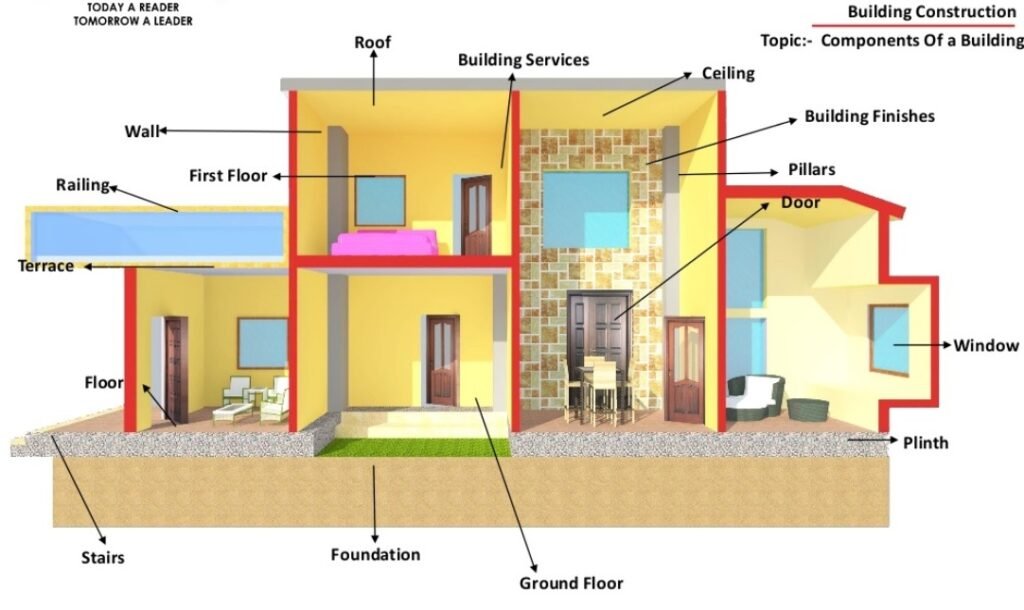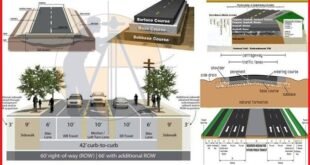Basic Components of Building Structure | Building Elements | Sub Structure | Super Structure
A building consists of the following basic components including Building Elements, substructure, and superstructure.

1. FOUNDATION | Building Elements
A foundation is necessary to evenly distribute the entire building load on the soil in such a manner that no damaging settlements take place. Hence, the foundations need to be constructed on good/solid ground.
2. PLINTH| Building Elements
A plinth is normally constructed just above the ground level and immediately after the foundation. It raises the floor above the ground level and herewith prevents surface water from entering the building.
3. DAMP PROOF COURSE (DPC) Building Elements
The damp proof course is a layer of waterproofing material such as asphalt or waterproof cement. Walls are constructed above the damp proof course.
Damp proof course prevents surface water from rising into the walls.
Dampness reduces the strength of the walls and creates unhealthy living conditions. Also, it affects the paint and plaster and increasing the cost of maintenance.
Damp proofing layer is not required where a plinth beam is constructed, because the plinth beam already performs like a DPC.
Learn More
Minimum Concrete Cover for Reinforcement What is Concrete Cover for Reinforcement
4. PLINTH BEAM Super Structure
A plinth beam is constructed depending upon the type of structure of the building and the nature of the soil. It provides additional stability in regard to settlements of the building and earthquake damages.
5. FLOOR Basic Components of Building Structure
This is the surface on which we do most of our activities. Flooring is laid over the filling of the plinth and on subsequent floors.
Flooring can be done with different materials, but care must be given that the ground below the floor is well compacted. Flooring is done to prevent dampness from rising to the top and to have a firm platform that can be kept hygienic and clean.
6. WALLS Basic Components of Building Structure
Walls are the vertical elements on which the roof finally rests. They can be made of different materials like bricks, stones, mud, concrete blocks, lateritic blocks, etc. If the walls are very long, columns can be provided to carry the roof.
Walls provide privacy and enclosure. Walls also provide security and protection against natural elements such as wind, rain, and sunshine.
Openings are to be provided in the wall for access and ventilation.
7. OPENINGS Super Structure Building Elements
Openings are normally provided in the walls as doors, windows, and ventilators.
Doors provide access; windows and ventilators provide light and ventilation.
Lintels are constructed just above the openings. It is normally a stone slab or a concrete slab.
Sill is the part of the wall that is just below the window.
Lintels are constructed to hold up the walls above the openings. In earthquake-prone areas, a continuous lintel beam is provided all over the walls.
8. STAIRS Basic Components of Building Structure
A stair is a sequence of steps and it is provided to afford the means of ascent and descent between the floors and landings.
The apartment or room of a building in which stair is located is called the staircase. Space or opening occupied by the stair is called a stairway.
There are different kinds of stairs are used in buildings, like RCC stair, wooden stair, metal stair, brick stair, etc.
9. ROOF Super Structure
The roof provides protection for the building and the people living in it. The roof rests on the walls and requires proper anchoring so that wind and other mechanical impacts cannot destroy it. A roof can have different shapes but it is always either flat or sloping.
The roof is typically made of RCC, stone slab, tiles, etc.
10. FABRICATION OF DOORS AND WINDOWS:
Openings are necessary for buildings for passages inside and outside the buildings.
We also need windows for lighting and ventilation.
A detailed study of doors and windows is an important part of building construction as the expenditure on this item alone can go up to 15 to 20 percent of the total cost of civil works.
Traditionally, doors and windows were made of wood, and hence, this work is sometimes referred to as woodwork in buildings.
Other woodworks like the provision of cupboards are also important, but it comes under the subject of interior decoration.
11. SURFACES / FINISHES Super Structure
External finishes are the outermost layer of protection, which protects the structure from weathering. Internal finishes are the layers given on internal faces. They give durability and a pleasing appearance to the inside.
Learn More
Method Statement for Formwork, Reinforcement and Concrete Works | Construction Engineering
12. BUILDING SERVICES: Basic Components of Building Structure
Water supply, drainage, sanitation, electric supply lifts, external works, construction of cupboard, etc. are considered as items outside of civil works and are called building services.
Water supply, drainage, and sanitation (building service).
These works are considered separate from civil works and are also estimated separately.
Design and details of these will be studied in public health engineering under building services.
However, an elementary treatment of the subject is always included in basic building construction.
Electrical works (building service).
Lighting and supply of electricity for various pieces of equipment used in buildings also come under building services.
The supply and distribution of electricity in a building is specialized work to be carried out by an electrical engineer.
However, the basics of these works are also usually dealt with in elementary building construction.
Usually, a lump sum equal to 25 to 30 percent of civil works is estimated as the probable expense for the above two items taken together.
Other Post
-
How To Estimate Per Meter Weight Of Reinforcing Steel Bar
-
What is crank Length of reinforcement
-
How do you take off a Staircase
 Surveying & Architects A unique platform of Civil Engineering
Surveying & Architects A unique platform of Civil Engineering
